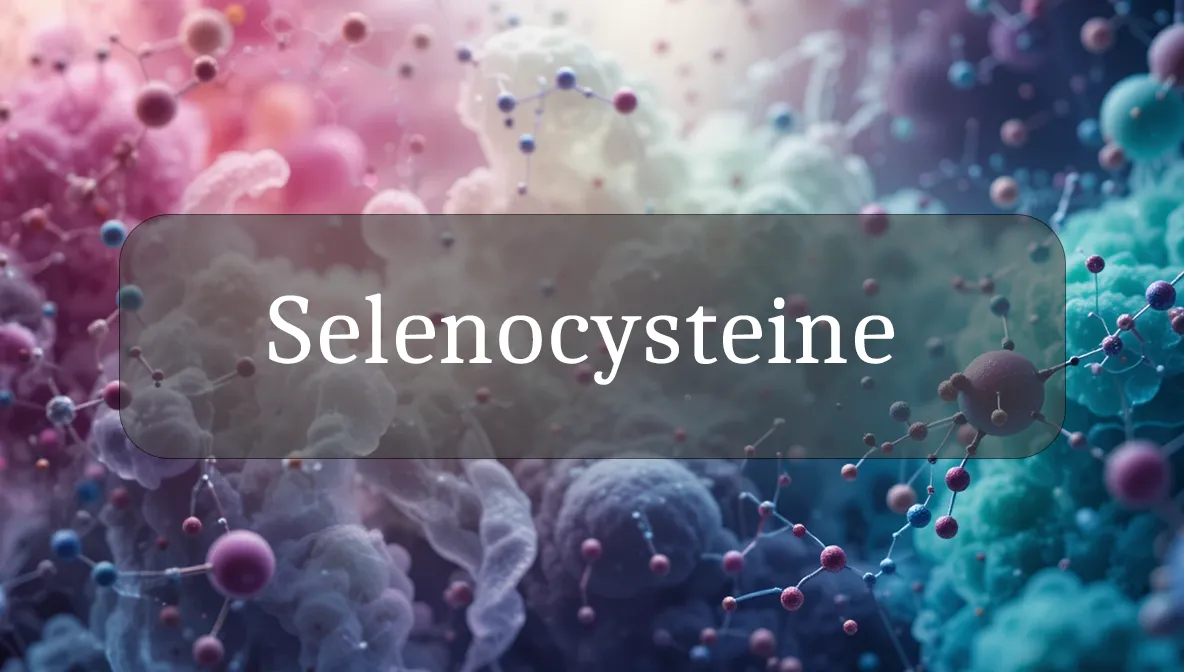Body’s Antioxidant Amino Acid
Selenocysteine, often called the “21st amino acid,” is like a specialized tool in your body, helping protect cells and support vital processes. This unique amino acid is a key component of proteins that fight damage and keep your body running smoothly. In this article, we’ll explore what selenocysteine is, how it benefits your health, and practical ways to support its function, all in a friendly, easy-to-read way for health-conscious readers.
Identity and Type
Selenocysteine is an amino acid, specifically a non-standard, proteinogenic amino acid with a structure similar to cysteine but with selenium replacing sulfur. It’s incorporated into certain proteins, called selenoproteins, during protein synthesis, using a special genetic code (the UGA codon, normally a stop signal). Selenocysteine is formed in the body from dietary selenium and serine, with help from specific enzymes. Think of it as a rare building block that gives certain proteins superpowers, especially for protecting cells and supporting metabolism.
Biological Role and Health Benefits
Selenocysteine is critical for the function of selenoproteins, offering several health benefits:
- Antioxidant Protection: Selenocysteine is a key part of enzymes like glutathione peroxidase, which neutralizes harmful free radicals, protecting cells from damage and reducing the risk of chronic diseases like heart disease or cancer.
- Supports Thyroid Health: It’s essential for enzymes (like deiodinases) that activate thyroid hormones, regulating metabolism, energy, and growth.
- Boosts Immune Function: Selenoproteins enhance immune cell activity, helping you fight infections more effectively.
- Promotes Heart Health: By reducing oxidative stress and inflammation, selenocysteine supports healthy blood vessels and heart function.
- Aids Detoxification: It helps protect against heavy metal toxicity and supports liver function, aiding your body’s detox processes.
These benefits make selenocysteine vital for staying energized, resilient, and healthy.
Dietary Sources and Supplements
Your body doesn’t store selenocysteine directly but makes it from dietary selenium. Key food sources and nutrients that support its production include:
- Selenium-Rich Foods: Brazil nuts (just 1–2 nuts daily), fish (tuna, sardines), eggs, poultry, and whole grains provide selenium for selenocysteine synthesis.
- Protein-Rich Foods: Meat, dairy, and legumes supply serine, a precursor to selenocysteine.
- Vitamin B6-Rich Foods: Bananas, potatoes, and spinach support the enzymes needed to form selenocysteine.
- Antioxidant Foods: Berries, leafy greens, and nuts complement selenocysteine’s protective effects by reducing oxidative stress.
- Supplements: Selenium supplements (e.g., selenomethionine or sodium selenite) can boost selenocysteine production, but doses above 200 mcg daily may be harmful, so consult a doctor.
Signs of Imbalance
Low selenocysteine levels, often due to selenium deficiency, can impair selenoprotein function, leading to symptoms:
- Fatigue or Weakness: Low energy from poor thyroid function or reduced antioxidant protection.
- Weak Immune System: Frequent infections or slow recovery due to impaired immune responses.
- Thyroid Issues: Symptoms like weight gain, cold sensitivity, or sluggishness, linked to poor thyroid hormone activation.
- Hair or Skin Problems: Brittle hair, nails, or dry skin from increased oxidative damage.
- Muscle Pain: Aches or weakness, as seen in conditions like Keshan disease (a rare heart condition tied to selenium deficiency).
Excess selenium (over 400 mcg daily) can cause toxicity, with symptoms like nausea, hair loss, or nerve issues. If you notice these signs, a healthcare provider may test selenium levels or thyroid function.
Supporting Optimal Levels or Function
To support selenocysteine production and maintain its benefits, try these practical wellness tips:
- Eat Selenium-Rich Foods: Include 1–2 Brazil nuts, fish, or eggs daily to provide selenium for selenocysteine synthesis, but avoid overconsumption.
- Balance Your Diet: Incorporate protein-rich foods (like poultry) and B6 sources (like spinach) to support selenocysteine formation.
- Exercise Moderately: Engage in 30 minutes of activities like walking or yoga most days to boost metabolism and antioxidant activity.
- Get Enough Sleep: Aim for 7–9 hours of quality sleep to support cellular repair and selenoprotein function.
- Limit Toxin Exposure: Avoid smoking or excessive alcohol to reduce oxidative stress and protect selenocysteine’s antioxidant role.
Safety, Interactions, and Precautions
Selenocysteine is produced naturally, but its levels depend on dietary selenium, and certain factors can affect its function:
- Selenium Toxicity: Excessive selenium intake (over 400 mcg daily from food/supplements) can cause selenosis, with symptoms like nausea, hair loss, or nerve damage.
- Nutrient Deficiencies: Low vitamin B6 or protein intake can impair selenocysteine synthesis, so ensure a balanced diet.
- Medications: Some drugs (e.g., chemotherapy agents) may affect selenium metabolism, so discuss with a doctor if you’re on long-term treatments.
- Chronic Conditions: Thyroid disorders, heart disease, or immune deficiencies may involve altered selenoprotein function, requiring medical management.
- Interactions: High doses of selenium supplements may interact with blood thinners or diabetes medications, so consult a healthcare provider.
Fun Fact
Selenocysteine, discovered in the 1970s, is called the “21st amino acid” because it’s one of only two amino acids (with pyrrolysine) added to the standard 20 in the genetic code. Its unique use of a “stop” codon (UGA) to encode a functional amino acid amazed scientists, showing how nature bends genetic rules!
Citations
- National Institutes of Health. (n.d.). Selenium and Selenoproteins in Health.
- Mayo Clinic. (2023). Selenium and Thyroid Function.
- Cleveland Clinic. (2024). Antioxidants and Selenocysteine’s Role.
- World Health Organization. (2022). Trace Elements in Nutrition.
- StatPearls – NCBI Bookshelf. (2023). Selenocysteine and Selenoprotein Functions.

